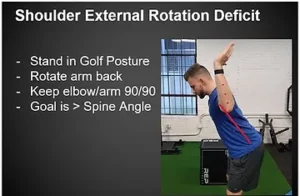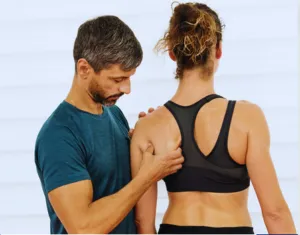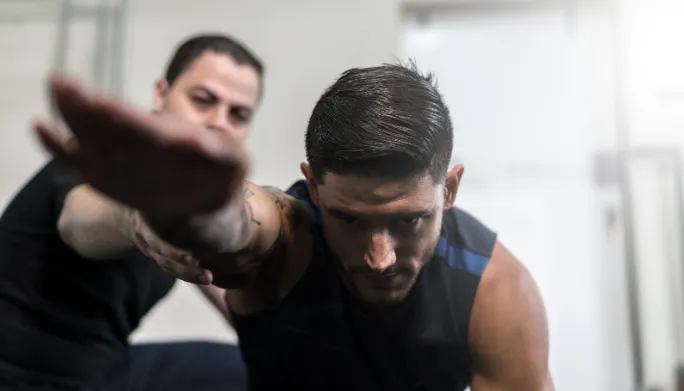Shoulder Mobility Is Critical For Golfers
The shoulder often feels pain first when there’s a problem with someone’s swing; aside from lower back pain, this is one of the most common areas to have soreness and limitation within a golf swing.
The hard part is that shoulder pain is sometimes not felt directly in the shoulder. Sometimes it presents as arm pain, achiness, soreness into the outside upper arm, into the elbow, or into the forearm.
We have 4 rotator cuff muscles at the shoulder that are very important for keeping the joint stable with any movement we choose to do with our arm. Those muscles are the supraspinatus, infraspinatus, teres minor and subscapularis.
The rotator cuff usually takes the blame too when something goes wrong with the shoulder.

“I have this catch, or this pain in my shoulder when I lift it up over my head”
“It’s probably impingement or your rotator cuff”
Surgery is a common road to go down when the rotator cuff is torn, but this should be a last resort! I’ve seen many people regain nearly full function of their shoulder without pain with a torn rotator cuff muscle; there are a lot of things that we can do to try to get you there too if you currently have a torn rotator cuff muscle. Even if you have surgery, it’s really important to do your rehab for it for the first 2 YEARS after surgery – not just the first 16 weeks.
Without having the right amount of mobility and stability at the shoulder, golfers will likely experience an over the top swing pattern, early extension, low back pain, blocked shots and inconsistent contact with the golf ball to name a few things. Shoulder range of motion is really important.
1 Simple Test of Shoulder Mobility for Golf Swing
To check the flexibility of your shoulder, raise your arms up like you are making a field goal post (elbow bent at 90 degrees), then get into a 5 iron posture for your golf swing (without a club) and with palms facing forward, try to rotate your forearm back as far as you can without the back arching / losing posture and without moving the elbow. Do you get your forearm past the angle that your spine is in? Check this blog article to see if you passed this test!

Be sure to test both sides. This is a common area for people to feel their shoulder tighten up, or feel like it gets stuck/kinked from going any further.
This test can really expose whether you have a problem with your backswing or into your downswing with how well you can rotate your shoulder into what’s called external rotation of the shoulder.
Right versus left, the most important direction to pass in this rotational center is whichever side is your trail arm in your downswing – this is critical for getting on the best swing plane to make the best contact with the ball. The lead shoulder is then important for being able to have a good follow through that allows you to finish your swing with confidence.
If you have trouble with this test it can impact your longevity as a golfer. Lacking mobility here can lead to lower back injuries because of compensation (think extra side bend). It also leads to a lot of elbow problems because excessive stress / force gets placed at the elbow region when the shoulder isn’t doing the full job that it needs to.
Improving Shoulder Mobility
The first focus should be on the thoracic spine and shoulders. The ability to expand our ribcage well with our breath vs. rigidity in the ribcage will impact how well the spine can turn. This effects how well your shoulder can turn due to the upper extremity kinetic chain of spine-shoulder-arm.
Soft tissue restrictions or an overly tight shoulder capsule (more common as we age) can be present too. These can be addressed via manual therapies such as dry needling, hands on muscle release, or other techniques to improve these restrictions.

Once mobility is improved, the next focus is on stability of the shoulder muscles through specific exercises.
Your Solution
The solution to a flexibility problem depends on how you move specifically – but a good area to begin with is building up mobility in the thoracic spine and stability through the lower back and core regions. Then we can determine whether there is a mobility problem OR a stability problem at the shoulder to be addressed; a stability problem is addressed is very differently from a mobility problem.
If there is pain present – this NEEDS to be addressed by a physical therapist first before doing general exercises.
If you haven’t already, checkout our GOLF HOME ASSESSMENT to see where you match to other golfers like you.
Remember to start working on improving your flexibility/mobility and strength little by little – you don’t need to do an hour of exercises each day. Start small with what you can consistently do for 5-10 minutes each day. Consistency over time with the right exercises will lead to improvements and results. If you can get 45 minutes a week working on your spine (preferably not at one time, but spread out throughout the week), that’s all you will need to start seeing results!
What’s Next?
If you’re currently in pain or dealing with tightness – give us a call or click here and let’s see how we can best help you get out of pain and resolve the tightness you’re having with life or with your golf swing.
Dr. Grant Bishop, PT DPT, TPI Certified


